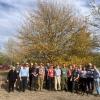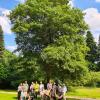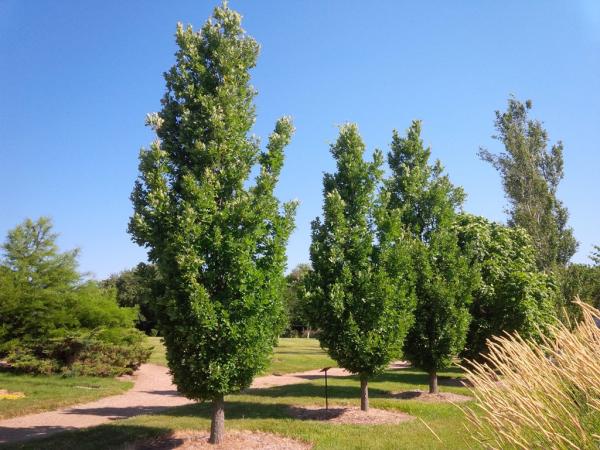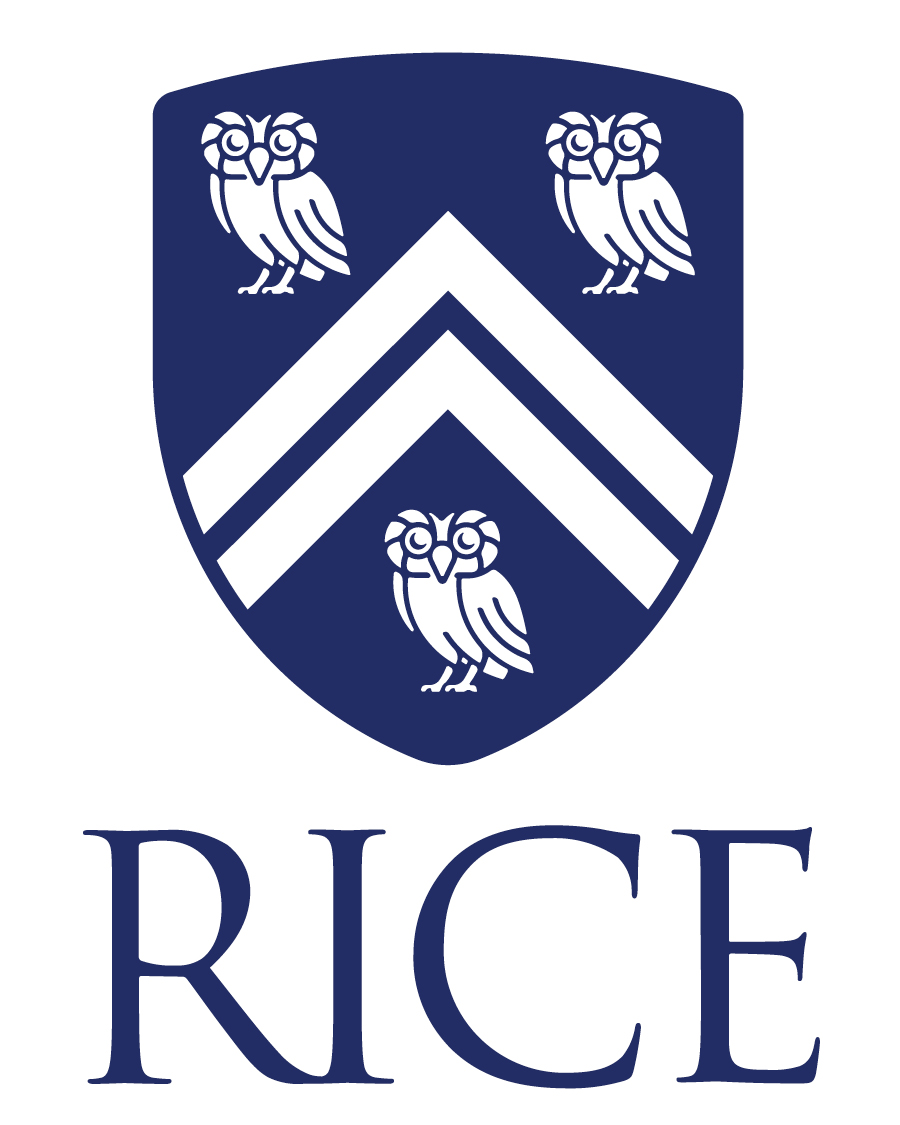Editor's Picks
Plant Focus
This July, twelve passionate researchers and practitioners from Guatemala, Costa Rica, Colombia, Mexico, and the United States came together in Oaxaca, Mexico, to share the latest findings on Mesoamerican oaks. The gathering took place during the annual meeting of the Association for Tropical Biology and Conservation (ATBC), offering a unique opportunity to spotlight these ecologically and culturally important trees.

David Douterlungne and Emma Villaseñor Sánchez are missing in the photo.
Despite the significance of Mesoamerican oaks, many gaps persist in our knowledge of them. We still lack detailed information about their population sizes, role in forest succession, geographic distributions, threats, and responses to climate change. Adding to the challenge is the complexity of oak identification, which hampers efforts to monitor biodiversity and implement effective conservation strategies.
The symposium emphasized how new insights into oak responses to environmental disturbance can guide more targeted conservation actions. It also called for restoration and conservation efforts to urgently consider the impacts of climate change and biodiversity loss—while integrating social dimensions that are too often overlooked in ecological studies.
Presenters shared cutting-edge research on oak taxonomy, evolutionary history, and ecological dynamics. They also explored promising strategies such as assisted migration to help vulnerable species adapt to changing climates. Importantly, the symposium highlighted how understanding the values and perspectives of smallholder communities—and addressing barriers to their participation—can strengthen conservation and restoration initiatives and foster long-term success.
The overarching aim of the symposium was to assess what we currently know, identify critical research needs, and build alliances to better protect endangered oak species. What follows is a summary of the research papers presented, each contributing a piece to the broader puzzle of oak conservation in Mesoamerica.
Conservation Gap Analysis of Mesoamerican Oaks: Establishing Conservation Priorities
Authors: Kate Good,1 Allen Coombes,2 Susana Valencia Ávalos,3 Maricela Rodríguez Acosta,4 Emily Beckman Bruns,1,5 Silvia Álvarez-Clare.1
1 The Morton Arboretum
2 Jardín Botánico Universitario de la Benemérita Universidad Autónoma de Puebla (JBU-BUAP)
3 National Autonomous University of Mexico, Mexico City (UNAM)
4 GCCO Mexico and Central America
5 Cyclopure

Mesoamerica is a global center for oak biodiversity (genus Quercus), with an estimated 164 species in Mexico alone. Despite this incredible diversity, for many species, little is known regarding population size, trends, occurrence, or threats. There is an urgent need to coordinate and prioritize conservation action for both in-situ and ex-situ populations.
We conducted a conservation gap analysis of 59 threatened and Data Deficient species of Mesoamerican oaks to estimate the geographic and ecological representation of species in ex-situ collections. Between 2017 and 2022, we distributed surveys to ex-situ institutions with a request for their Quercus accessions data. There were 197 institutions that reported living collections of at least one Mesoamerican oak, a majority of which are in the United States (49%) and Europe (32%), with only 5% of the species having at least one collection in Mesoamerica. Twenty-two of our target species are not held in any ex-situ collections, anywhere in the world.
We found that only 3 of the 59 target species have ex-situ collections that represent more than 50% of the species’ geographic range, and only 19 species have an ecological coverage greater than 50%. Furthermore, approximately one fourth (16/59) of the target species have less than 10% of their native range within protected areas. Climate change was identified as a threat for all 59 threatened or Data Deficient Mesoamerican oak species. Additionally, agriculture and residential or commercial development represented threats to 72% and 69% of the species, respectively.
Our results highlight the need for expanding survey and exploration work, increasing representation of oak species in botanic gardens and arboreta (particularly in Mesoamerica) and identifying priority regions, species, and activities to focus both in-situ and ex-situ conservation efforts.
Challenges of Oak Taxonomy in Mexico and Their Implications for Conservation
Authors: Antonio González Rodríguez,1 Oscar De Luna,1 Saddan Morales,2 Ken Oyama,1 Susana Valencia Ávalos,1 M. Socorro González Elizondo.3
1 Universidad Nacional Autónoma de México
2 Instituto de Ecología A.C.
3 Insitituto Politécnico Nacional

Oaks are very diverse in Mexico, with a total estimated number of species around 160 and 100 endemics. However, considerable taxonomic confusion remains in the Mexican oaks, mainly related to their relatively recent evolutionary origin and frequent interspecific hybridization. Integrative taxonomy, which combines evidence from different sources (i.e., population genetics, phylogenomics, morphometry, traditional morphology, ecological niche modelling), offers a promising approach for solving some of the taxonomic challenges in oaks. Recently, we have used these tools to study complicated species groups in Mexico, such as the Quercus laeta and Q. microphylla species complexes.
Our results have contributed to understanding and delineating species boundaries in these groups, but at the same time, have shown that taxa previously considered as widespread polymorphic species actually consist of geographically restricted, separate lineages that may merit species status. While contributing to the clarification of taxonomic issues, this information raises conservation concerns, since the number of oak taxa considered as threatened in Mexico would need to be revised.
Geospatial and Functional Diversity Contrasts in Evolutionary Lineages of Quercus: Mexico and Central America
Authors: Reyna Maya,1 Susana Valencia Ávalos,2 Alberto Ken Oyama Nakagawa,2 Andrés Torres Miranda.3
1 Escuela de Estudios Superiores Unidad Morelia-UNAM
2 Universidad Nacional Autónoma de México
3 Universidad Nacional Autónoma de México
4 Escuela de Estudios Superiores Unidad Morelia-UNAM
This study offers a thorough and precise analysis of the phylogenetic diversity, distribution patterns, and functional traits of oak species (Quercus) in Mexico and Central America. It effectively addresses the environmental contrasts between the two main oak sections—Quercus (white oaks) and Lobatae (red oaks)—and examines the altitudinal and spatial diversity patterns, including the patterns of species richness, rarity, and endemism. The study also identifies the distribution of tree and shrub life forms and analyzes functional traits related to structural, foliar, and reproductive characteristics.
More than 40,000 records of 155 species were refined, and databases were created containing morphological, geographic, and environmental information from morphological taxonomic reviews of the genus. The geographic and altitudinal distribution patterns of the species were analyzed using units of both low- and high-geographic resolution, alongside the assessment of the morpho-functional patterns. Multiple correlations were conducted between diversity patterns and environmental variables such as temperature and precipitation.
The results indicate that species richness is highest in east-central and southeastern Mexico. Rarity is concentrated in the northern Sierra Madre Oriental and central-west Mexico. The greatest richness occurs between 1,800 and 2,400 meters above sea level. Temperature and precipitation heterogeneity are key factors associated with high diversity. Therefore, conservation efforts must explicitly incorporate the concept of environmental exclusion, which refers to the influence of ecological, climatic, geographic, or biological factors that limit species presence and distribution within ecosystems.
This approach is essential for designing effective conservation and restoration strategies and for identifying key habitats. It is also vital to recognize the topographic heterogeneity that shapes different species assemblages and their morpho-functional differences within the two main oak lineages.
Mesoamerican Cloud Forest Oaks Under Threat: Insights from Genomics
Authors: Hernando Rodríguez Correa,1 Sofía Zorrilla Azcué,1 Ken Oyama,1 Sergio Marrugo Rondon,1 Santiago Ramírez Barahona,2 Melissa Naranjo Bravo1, Silvia Álvarez-Clare.3
1 Escuela Nacional de Estudios Superiores Unidad Morelia, Universidad Nacional Autónoma de México
2 Instituto de Biología, Universidad Nacional Autónoma de México
3 The Morton Arboretum

Cloud forests are highly vulnerable to the effects of rapid climate change, with rising temperatures and lifting cloud bases that dry slopes. Their canopy trees are susceptible: they live for centuries, disperse slowly and cannot simply climb uphill.
To gauge their prospects, we analyzed genetic variation and historical demography in two flagship oaks, Quercus insignis and Q. skinneri. Preliminary results reveal pronounced genetic structure across Q. insignis populations in Mexico and Central America, the legacy of long‑term in‑situ persistence rather than recent recolonization. Climate‑envelope projections warn that about 40 % of its suitable habitat could disappear by 2080, trapping stands on humid “islands” in Chiapas–Guatemala and Costa Rica–Panamá. Genotype–environment tests show that roughly one quarter of allelic diversity follows local climate, signaling an impending mismatch between genomes and future conditions. For Q. skinneri, population genomics uncovers evolutionarily significant lineages aligned with geological blocks from Veracruz to Honduras. Effective population sizes collapsed during the mid‑Pleistocene and remain low, amplifying extinction risk through genetic drift. Unlike Q. insignis, Q. skinneri is not limited by the barrier of the Isthmus of Tehuantepec, implying that past lowland corridors are now severed.
These patterns translate into urgent conservation tasks. We must shield small humid strongholds, restore upslope corridors across bottlenecks, and test assisted gene flow. Each lineage should be managed as an independent conservation unit, with forest nuclei safeguarded and targeted reforestation used to reconnect gene‑flow pathways. Together, Q. insignis and Q. skinneri remind us that cloud‑forest oaks have survived a million years of climatic whiplash by hunkering down in scattered refuges, not necessarily by sprinting uphill. Their future depends on knitting those refuges into functional networks before the climate treadmill outruns their life cycles. Linking evolutionary insight with forward‑looking models offers a precision toolkit to keep these sky‑island sentinels standing tall.
Alternative Stable Successional States Explain Secondary Shrubland Persistence in Mexican Oak Forests with Land-Use Legacies
Authors: David Douterlungne,1 Sandra Hernández Valdez,2 Rubicel Trujillo Acatitla,2 José Tuxpan. 3
1 David Douterlungne, IPICYT - CECIHTI - Laboratorio Micelio
2 IPICYT
3 IPICYT - CECIHTI

Human-modified forest mosaics, shaped by logging, agriculture, and livestock grazing, face reduced resilience and potential threshold crossings into alternative stable states. The underlying mechanisms responsible for these long-term species composition shifts are still poorly understood, despite the growing need to manage these human-modified landscapes for biodiversity and productivity.
In Central Mexico’s oak forests, we investigated how agricultural and livestock legacies drive such transitions. Across 36 transects (9,000 m²) with diverse land-use histories, we analyzed vegetation, soil, disturbance, NDVI time series (1972–2019), and seedling composition to past and current successional states and their interaction with human disturbance. NMDS, PERMANOVA, and ANOVA revealed three distinct communities resulting from different land use histories: (1) oak forest (late-successional Quercus species), (2) secondary shrubland (Vachellia-Dodonaea association), and (3) transitional forest-shrub mixes. NDVI trends and seedling recruitment confirmed long-term community segregation. Variation partitioning showed anthropogenic disturbance—particularly livestock browsing—exerted stronger influence on composition than environmental factors.
We propose a state-and-transition model where cattle browsing and agricultural legacies shift oak forests to shrublands via three feedbacks: (i) micro-environmental filtering, (ii) plant-trait-mediated assembly, and (iii) recruitment inhibition by browsing. These interacting mechanisms stabilize shrub dominance, impeding forest recovery. This framework elucidates successional dynamics in multi-use landscapes, offering a tool to guide restoration by targeting critical thresholds.
Our findings underscore the disproportionate impact of chronic anthropogenic pressures, notably livestock, in overriding environmental drivers of community assembly. Managing such systems requires mitigating browsing and agricultural legacies to prevent irreversible transitions, aligning biodiversity and productivity goals in human-dominated forests.
Resilience and Decline Patterns of Quercus oleoides in Dry Tropical Ecosystems
Authors: Kenneth Barrantes Fallas,1 Silvia Álvarez-Clare,2 Junior Pérez Molina,3 José Vargas Murillo,4 Andrea G. Vincent.3
1 Sistema Estudios de Posgrado, Universidad de Costa Rica
2 The Morton Arboretum
3 Escuela de Biología, Universidad de Costa Rica
4 LEFET, Universidad Nacional de Costa Rica
The 2015–2016 El Niño drought in Costa Rica caused severe tree mortality, raising concerns about the future of dry tropical forests. Local populations of the tropical lowland oak Quercus oleoides were severely affected, with many showing decline symptoms. Yet little is known about its current health or resilience to future climates. Given its occurrence across resource gradients—from dry, nutrient-poor savannas to wetter, more fertile dry forests—Q. oleoides offers a unique opportunity to study tropical oak resilience. Understanding its status is vital to safeguard this keystone species and its ecosystems. This study aimed to determine the population structure and demographic trends of Quercus oleoides in two dominant habitat types (forest and savanna).
Between 2024 and 2025, we conducted two censuses, recording 861 reproductive and over 3,000 non-reproductive individuals. We measured diameter at breast height (DBH) for reproductive trees and basal diameter at ground level for non-reproductive individuals. These data were used to build Lefkovitch matrices, perform elasticity and Life Response Experiment analyses, and construct cohort matrices to estimate growth rates and identify key life stages for conservation actions. Population growth rates (λ) indicated a declining trend for reproductive individuals in both ecosystems, with a steeper decline in dry forests (λ = 0.896) compared to savannas (λ = 0.927). Savanna populations exhibited an inverted J distribution with continuous size classes, while dry forest populations were dominated by individuals with DBH greater than 25 cm, suggesting an aging population. For non-reproductive individuals, savannas showed population growth (λ = 1.204); in contrast, although dry forests had three times the density of non-reproductive individuals, only seedlings with diameters below 1 cm were recorded, revealing a major gap in intermediate stages and indicating high recruitment but low establishment and transition to larger size classes.
The observed population declines in both ecosystems, along with the lack of seedling establishment in dry forests, point to an aging population without demographic replacement. This may indicate the potential for local populations to collapse under future large-scale disturbances.
Assisted Migration of Cloud Forest Oaks
Authors: Tarin Toledo Aceves,1,2 Vinicio Sosa,1 Cuauhtémoc Sáenz,2,3 Víctor Vásquez,1 Flor Vázquez Corzas,4 Claudia Gallardo,1 Emma Villaseñor,1 Estrella Chevez,1 Silvia Álvarez-Clare.5
1 Instituto de Ecología A.C. (INECOL)
2 Laboratorio Nacional de Biología del Cambio Climático (LANBIOCC)
3 INIRENA, Universidad Michoacana de San Nicolás de Hidalgo
4 Pronatura Veracruz A.C.
5 The Morton Arboretum

Global climate change is affecting tree species recruitment, particularly in tropical montane forests, where rising temperatures lead to mortality at lower elevations and upward migration. Oaks are crucial to the structure of cloud forests in Mexico, but deforestation and limited dispersal may hinder their migration. Assisted migration could help overcome the uncoupling between species dynamics with climate change, but knowledge of tropical tree species' responses is limited.
We assessed the impact of Climatic Transfer Distance (CTD) on the survival and growth of 13 endangered cloud forest tree species, including two oak species. The CTD represents the difference between historical climate at the seed source and current climate at translocation sites. We planted 30 seedlings per species at eight forest sites along an elevation gradient (1250–2429 m a.s.l.). We analyzed survival and growth responses to CTD in terms of Mean Annual Temperature (CTD_MAT), Maximum and Minimum Temperatures (CTD_Tmax, CTD_Tmin), Mean Annual Precipitation (CTD_MAP), and Climate Moisture Deficit (CTD_CMD). Survival declined with increasing CTD_MAT, CTD_MAP, and CTD_CMD, while growth decreased with increasing CTD_Tmax, CTD_MAT, CTD_MAP, and CTD_CMD, particularly in warmer and drier sites. After eight years, high sapling survival occurred: 83% in Quercus germana and 68% in Q. sartorii.
Based on these results, we established 60 restoration plantings with eight oak species, across various land uses and elevations (1051–2519 m a.s.l.) in Veracruz, Mexico. After one year, survival rates were: Q. germana = 92.0%, Q. xalapensis = 92.1%, Q. sartorii = 80.0%, Q. calophylla = 77.6%, Q. pinnativenulosa =78.5%, Q. meavei = 71.0%, Q. delgadoana = 68.0%, and Q. cortesii = 63.2%. Prior land use, elevation, soil properties, and maintenance interventions did not affect oak survival.
These findings suggest that cloud forest oaks have broad environmental tolerance, offering hope for their establishment in new sites and under changing climates.
Assisted Regeneration in Urban Cloud Forests: Performance of Three Oak Species
Authors: María Toledo Garibaldi,1 Tarin Toledo Aceves.1,2
1 Instituto de Ecología A.C. (INECOL)
2 Laboratorio Nacional de Biología del Cambio Climático (LANBIOCC)

Deforestation and unplanned logging are affecting the populations of many oak species in Mesoamerican forests. In highly diverse tropical landscapes, urban and peri-urban forests can play a crucial role as reservoirs of biodiversity, including species with conservation value. However, as the natural regeneration of old growth forest tree species is frequently limited, the assisted regeneration of tree species (directly planting trees) is a promising strategy to recover populations, and the diversity and functions of degraded forests.
To assess the success of enrichment plantings, we planted three threatened oak species (Q. delgadoana, Q. sapotifolia, and Q. xalapensis) in urban and peri-urban forests in a tropical montane cloud forest landscape in Mexico. After 20 months, survival was 30.0 ± 6.2% in Q. xalapensis, 41.6 ± 9.3% in Q. delgadoana, and 45.0 ± 7.4% in Q. sapotifolia. Growth differed among species: 0.028 ± 0.005 cm/mo in Q. xalapensis, 0.026 ± 0.006 cm/mo in Q. delgadoana, and 0.039 ± 0.006 cm/mo in Q. sapotifolia. Precipitation and initial seedling height at the time of planting, positively influenced the survival, while temperature had a negative effect; none of the explanatory variables affected growth. The Quercus species displayed low survival compared to plantings in other disturbed habitats such as secondary forests (> 80% survival after three years), and pasturelands (57% after three years).
Our findings indicate that the individuals of the Quercus species studied should be taller at the time of planting, and the selection of urban forest areas must consider the climatic conditions. The analysis of the performance of other Quercus species is recommended given the interspecific variation in the response to environmental conditions within this group, underscoring the need for species-specific strategies in restoration efforts.
Sharing Collaboration Experiences in Research and Conservation Actions for Oaks in Guatemala
Authors: Maura Quezada,1,3 Louudes Rodas Duarte,1 Andrea Marroquín Tintí.2,3
1 Centro de Estudios Conservacionistas. Facultad de Ciencias Químicas y Farmacia. Universidad de San Carlos de Guatemala
2 Centro Universitario de Nororiente. Universidad de San Carlos de Guatemala
3 Instituto de Investigaciones Químicas, Biológicas, Biomédicas y Biofísicas. Facultad de Ciencias Químicas y Biológicas. Universidad Mariano Gálvez Guatemala
Oaks (Quercus spp.) are key components of Guatemala’s forest structure. However, despite their ecological and cultural importance, they remain one of the least studied plant groups in the country. In 2015, a systematic effort began to update the existing knowledge on this group, which had not been reviewed since the publication of the Flora of Guatemala in 1952.
Over five years, with support from national funding, updated information was gathered in 15 of the country’s 22 departments, significantly expanding the known distribution of oak species both regionally and nationally. Ethnobotanical workshops were held to document the importance of oak forests for the well-being of local communities.
During this time, partnerships were established with governmental and non-governmental organizations, forming a local and international network to promote oak research and conservation. This network has enabled the continuation of oak studies in Guatemala even in the absence of formal funding.
The 2019 release of the field guide Oaks of Guatemala, Vol. 1 made this knowledge more accessible, becoming a valuable tool for forestry technicians and the general public. It also facilitated the organization of workshops for both technical staff and community members, raising awareness and providing botanical guidance to aid in species identification. These efforts have strengthened local botanical capacity and increased public interest in the conservation of oaks.
Currently, the team is working to promote the inclusion of oak species in municipal and community nurseries. As a result of various collaborations, Quercus is now being recognized as a key element in the development of forest landscape management, conservation, and restoration strategies in Guatemala.
Strategies for the Conservation and Restoration of Quercus insignis in Costa Rica
Authors: Heiner Acevedo Mairena,1 Silvia Álvarez-Clare.2
1 Asociación Pronatura Agathos Costa Rica
2 The Morton Arboretum

The white oak (Quercus insignis), an emblematic tree of Mesoamerican cloud forests, is facing severe fragmentation of its populations due to deforestation and land-use change. Classified as Endangered (EN) in the IUCN Red List, its conservation requires urgent actions based on ecological knowledge and active restoration.
Costa Rica is implementing the Action Plan for the Conservation of Quercus insignis (2025–2034), which combines science, community participation, and habitat restoration. The plan focuses on five key areas: (1) generating scientific knowledge, (2) protecting and restoring habitats, (3) propagating and planting seedlings, (4) raising awareness and educating local communities, and (5) building alliances among institutions and landowners.
Between 2023 and 2024, 15 field expeditions located 43 trees in protected areas and private lands. Seeds were collected from six sites and propagated in community nurseries, producing over 1,800 seedlings. These young trees are now being planted in degraded areas and water recharge zones, with the active participation of community groups and local water supply associations.
The work is showing promising results, but seed production in 2024 has been unusually low, possibly due to natural cycles of irregular seed production (masting). This highlights the urgency of continuing research and expanding restoration efforts before more populations are lost.
Engaging Communities in Cloud Forest Restoration: Socioeconomic Factors and Values Shaping Participation
Emma Villaseñor Sánchez 1, Estrella Chévez Martín del Campo 1, Flor Vázquez Corzas 3, Claudia Gallardo Hernández1 , María Toledo Garibaldi 1, Adrián Cabrera Valenzuela 1, Silvia Álvarez-Clare 4, Tarin Toledo Aceves 1,2.
1 Instituto de Ecología A.C. (INECOL)
2 Laboratorio Nacional de Biología del Cambio Climático (LANBIOCC)
3 Pronatura Veracruz A.C.
4 The Morton Arboretum

The cloud forest is a highly biodiverse ecosystem, which provides multiple benefits for people, mainly hydrological. Therefore, it is a priority ecosystem for restoration.
This presentation is part of a cloud forest restoration project in central Veracruz. Its global objective is to safeguard and recover cloud forest ecosystems through actions that involve stakeholders and respect local knowledge and perceptions. To achieve this, mixed plantations with thirteen native species were established in riparian areas and along the boundaries of plots belonging to 60 participants. Participants were involved in the planning process and in some experience and knowledge-sharing and capacity-building activities.
From a social perspective, the research aimed to understand the factors influencing households’ decisions to participate in restoration efforts. Semi-structured interviews were conducted on the socioeconomic characteristics of families, as well as the perceived benefits and barriers related to tree planting and participation.
The results indicate that participants attribute different values to trees, with relational values being a key factor in their management decisions. Understanding the socioeconomic factors and value systems associated with restoration practices is essential for designing more equitable initiatives with greater chances of long-term success.















